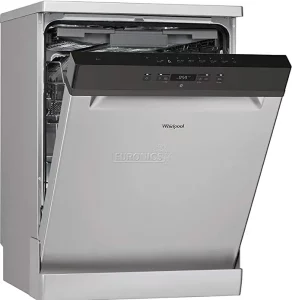Sections in this Manual
- PRODUCT DESCRIPTION
- FIRST TIME USE SALT, RINSE AID AND DETERGENT
- FILLING THE SALT RESERVOIR
- SETTING THE WATER HARDNESS
- FILLING THE RINSE AID DISPENSER
- ADJUSTING THE DOSAGE OF RINSE AID
- FILLING THE DETERGENT DISPENSER
- PROGRAMS TABLE
- PROGRAMS DESCRIPTION
- OPTIONS AND FUNCTIONS
- DRAIN OUT
- LOADING THE RACKS
- LOWER RACK
- DAILY USE
- MODIFYING A RUNNING PROGRAM
- ADDING EXTRA CROCKERY
- ACCIDENTAL INTERRUPTIONS
- ADVICE AND TIPS
- UNSUITABLE CROCKERY
- DAMAGE TO GLASS AND CROCKERY
- TIPS ON ENERGY SAVING
- HYGIENE
- CARE AND MAINTENANCE
- WATER SOFTENING SYSTEM
- TROUBLESHOOTING
- FAQs
WATER SOFTENING SYSTEM
Water softener automatically reduces water hardness, consequently preventing scale buildup on heater, contributing also to better cleaning efficiency.
This system regenerates itself with salt, therefore it is required to refill salt container when empty.
Frequency of regeneration depends on water hardness level setting regeneration takes place once per 5 Eco cycles with water hardness level set to 3.
Regeneration process starts in final rinse and finishes in drying phase, before cycle ends.
- Single regeneration consumes: ~3.5 L of water;
- Takes up to 5 additional minutes for the cycle;
- Consumes below 0.005 kWh of energy.
TROUBLESHOOTING
In case your dishwasher doesn’t work properly, check if the problem can be solved by going through the following list. For other errors or issues please contact authorized After-sales Service which contact details can be found in the warranty booklet. The manufacturer ensures the availability of spare parts for at least 10 years after production date of this appliance.
| PROBLEMS | POSSIBLE CAUSES | SOLUTIONS |
| Salt indicator is lit | Salt reservoir is empty (after refill the salt indicator may remain lit for several wash cycles). | Refill reservoir with salt (for more information – see page 2). Adjust water hardness (see table, page 2). |
| Rinse aid indicator is lit | Rinse aid dispenser is empty (after refill the rinse aid indicator may remain lit for several wash cycles). | Refill dispenser with rinse aid (for more information – see page 2). |
| The dishwasher won’t start or does not respond to commands. | The appliance has not been plugged in properly. | Insert the plug into the socket. |
| Power outage. | For safety reasons, dishwasher will not restart automatically when power returns.
Press the START/Pause button to resume the cycle. Vigorously push the door until you hear the “click”. |
|
| The dishwasher door is not closed. | ||
| Cycle is interupted by door opening for > 4 sec. | Close the door and press START/Pause. | |
| It does not respond to commands.
Display shows: F9 or F12 and both On/Off and START/Pause LEDs are blinking rapidly. |
Switch off the appliance by pressing the ON/OFF button, switch it back on after approximately one minute and restart the program. If problem persists, unplug the appliance for 1 minute, then plug it back in. | |
| The dishwasher won’t drain.
Display shows: F3 and both On/Off and START/Pause LEDs are blinking rapidly. |
The wash cycle has not finished yet. | Wait until the wash cycle finishes. |
| The drain hose is bent. | Check that the drain hose is not bent (see INSTALATION INSTRUCTION). | |
| The sink drain pipe is blocked. | Clean the sink drain pipe. | |
| The filter is clogged up with food residues. | Clean the filter (see CLEANING THE FILTER ASSEMBLY). | |
| The dishwasher makes excessive noise. | The dishes are rattling against each other. | Position the crockery correctly (see LOADING THE RACKS). |
|
An excessive amount of foam has been produced. |
The detergent has not been measured out correctly or it is not suitable for use in dishwashers (see FILLING THE DETERGENT DISPENSER). Restart dishwasher by pressing the DRAIN button (see OPTIONS AND FUNCTIONS) and run new program without detergent. | |
| The dishes are not clean. | The crockery has not been arranged properly. | Arrange the crockery correctly (see LOADING THE RACKS). |
| The spray arms cannot rotate freely, being hindered by the dishes. | Arrange the crockery correctly (see LOADING THE RACKS). | |
| The wash cycle is too gentle. | Select an appropriate wash cycle (see PROGRAMS TABLE). | |
| An excessive amount of foam has been produced. | The detergent has not been measured out correctly or it is not suitable for use in
dishwashers (see FILLING THE DETERGENT DISPENSER). Make sure the cap of the rinse aid dispenser is closed. |
|
| The cap on the rinse aid compartment has not been shut correctly. | ||
| The filter is soiled or clogged. | Clean the filter assembly (see CARE AND MAINTENANCE). | |
| There is no salt. | Fill the salt reservoir (see FILLING THE SALT RESERVOIR). | |
| The dishwasher does not fill the
water. Display shows: and F6, both On/ Off and START/Pause LEDs are blinking rapidly. |
No water in the water supply or the tap is closed. | Make sure there is water in the water supply or the tap running. |
| The inlet hose is bent. | Make sure the inlet hose is not bent (see INSTALLATION) reprogram the dishwasher and reboot. | |
| The sieve in the water inlet hose is clogged; it is necessary to clean it. | After having carried out the verification and cleaning, turn off and turn on the dishwasher and restart a new program. | |
| Dishwasher finishes the cycle prematurely. Display shows: F5 and both On/Off and START/Pause LEDs are blinking rapidly. |
Drain hose positioned too low or siphoning into home sewage system. |
Check if end of drain hose is placed at correct height (see INSTALLATION).Check for siphoning into home sewage system, install air admittance valve if necessary. |
| Air in water supply. | Check water supply for leaks or other issues letting air inside. |
Policy and standard documentation and additional product information can be found by:
- Visiting our website docs.whirlpool.eu
- Using QR Code
- Alternatively, contact our After-sales Service (See phone number in the warranty booklet).
When contacting our After-sales Service, please state the codes provided on your product‘s identification plate.
The model information can be retrieved using the QR-Code reported in the energy label. The label also includes the model identifier that can be used to consult the portal of the registry at https://eprel.ec.europa.eu (available only on certain models).
FAQs
Are whirlpools a good dishwasher?
According to a leading consumer testing organization, Whirlpool belongs to the list of the most reliable dishwashers. This explains Whirlpool’s popularity in the USA. As an American manufacturer that makes most of their products right here at home, costs of repairs and spare parts are cheaper than other brands.
What is the most common problem with a dishwasher?
The most common cause of issues with water flow in a dishwasher is a defective water inlet valve. If the inlet valve is malfunctioning, it may not pull water into the appliance when you need it
How long is Whirlpool dishwasher warranty?
ONE-YEAR FULL WARRANTY
For one year from the date of purchase, when this dishwasher is operated and maintained according to instructions attached to or furnished with the product, Whirlpool Corporation will pay for FSP® replacement parts and repair labor to correct defects in materials or workmanship
Why does my Whirlpool dishwasher not dry?
Overloading and improper loading of the dishwasher are two of the most common reasons a Whirlpool dishwasher doesn’t dry effectively. Avoid overloading by leaving adequate space for air to circulate between each item
Can you just dry dishes in dishwasher Whirlpool?
Using a heated dry cycle in your Whirlpool dishwasher.
Using a heated dry cycle is the best way to insure that your dishes will be the most dry at the end of the cycle.
Is it OK to run an empty dishwasher?
Run the hottest cycle on the dishwasher. Skip the drying cycle and open the dishwasher door to let it air-dry. You can also sprinkle 1 cup of baking soda on the floor of an empty dishwasher and run a short cycle on the hottest setting to clean the interior and kill odors.
Should you leave your dishwasher door open?
It’s best to leave the dishwasher’s door open for a little while after running a cycle, as keeping it shut creates a warm, damp environment that is very comfortable for mould and other microbe
Is it OK to leave dishes in dishwasher overnight?
“Bacteria on [dirty dishes] will breed overnight, but if they go into the dishwasher the next day and they’re thoroughly washed then there won’t be a problem
Should I run my dishwasher half full?
Half-Full Wash Cycles Work Fine
It’s all about finding a happy medium. A half-full cycle is a waste to run, but overloading your dishwasher won’t do any good. The load size of your dishwasher will vary depending on the model, so maybe it is a good idea to check your user manual after all.
Why is it better to run dishwasher at night?
While peak hours will vary slightly by area, as a general rule, the cheapest time to run your dishwasher is at night—when people begin to turn off lights and TVs and the grid is less busy.
How often should you clean the dishwasher?
Clean your dishwasher monthly to prevent a buildup of germs and maintain the efficiency of the machine — you want to make sure your dishes are clean! Pour distilled white vinegar into a dishwasher-safe cup (I usually use a two-cup Pyrex measuring cup), and place the cup upright on an empty dishwasher’s top rack.
Do dishwashers clean better than hand washing?
The answer: washing dishes in the dishwasher provides much cleaner dishes than hand-washing. Even those dishes that don’t come completely clean in the washer have less bacteria on them than most hand-washed dishes.
Does a dishwasher save more water than hand washing?
According to Klien, “Handwashing can use as much as 27 gallons of water per load, while an energy-saving dishwasher uses only around three gallons.


